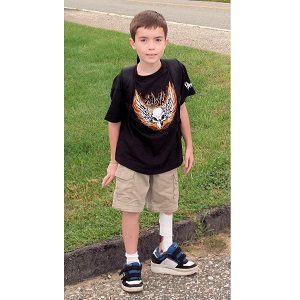 My son was born in 2000 with a dual diagnosis of VACTERL association and SA/CRS due to various congenital anomalies including sacral agenesis.
My son was born in 2000 with a dual diagnosis of VACTERL association and SA/CRS due to various congenital anomalies including sacral agenesis.
In the world of sacral agenesis, my son is kind of an anomaly within anomalies. Most people who are affected by SA/CRS have a bilateral anomaly of the sacrum, having a whole level of vertebra either missing or malformed. Differences lie in the level and extent of the malformation. Some may have smaller than normal bones of the sacrum on the mild end, all the way up to missing the entire sacrum and even the lumbar and possibly some of the thoracic vertebrae also for the more severely affected.
My son, however, has all his bones up to the sacrum, along with an extra hemivertebra, which for him is like a small pebble wedged between the bottom of his L5 vertebra and his… L6 I guess you would call it? He has an extra lumbar bone.
He then has four sacral bones (his tailbone is totally missing), with his right hip attaching to the top one like usual. That is where all things ”usual“ end as the entire left half failed to form, giving him what is called a “hemisacrum” Because of this, his left hip has no place to attach to, so it attached higher up to the lumbar spine, and this caused his hips to be uneven. His nerves to the left side were also affected and, because of this, his entire leg and foot were affected on that side. He is missing the two outer layers of buttock muscle. His left leg is smaller and shorter, with no muscle below the knee and he had a clubfoot… much like the legs you see in many of those those who have SA/CRS. The only difference for him is that the right leg is unaffected and looks totally “normal.”
Because of this, his hips were not level, and that combined with the shorter left leg caused his spine to curve in his body’s attempt to compensate for the issues below. He had surgery on his foot at a year old to correct the clubbing (after some stretching, taping and wearing an AFO brace as an infant), and he wore a shoe lift from the age of 14 months, which grew larger as his length discrepancy between the two legs grew.
Having only one leg affected has been a double–edged sword. On one hand, having the unaffected leg gave him some additional strength and endurance with walking that he would not have had otherwise, but on the other hand, it created a length imbalance that put a strain on his spine and required years of wearing an increasingly larger shoe lift. He needed a spinal fusion surgery at the age of 6 because of a progressing curve (his spine looked almost like a J before the surgery), and they straightened the spine and screwed rods into his pelvis on either side to stabilize the whole area. He had leg lengthening surgery at age 11 and gained 6.3 cm of new bone on the left, and will need another small lengthening once he gets near full growth to finish evening the legs out.
One of the side effects of this has been being what I call “in the middle.” My son does not need a wheelchair full time, he can get around well enough walking if he has enough time and with decent terrain (like inside the school setting). Longer distances, uneven terrain, warmer weather and a need for speed (for example, keeping up with groups on field trips) require him to use a wheelchair. In life, he’s not affected enough to be considered really “disabled,” but he is too affected to be considered “fully abled.” He straddles the middle of two worlds, a part of each but not fully belonging to either one. He has not felt the full impact of having his physical mobility tested at every turn and having to find alternatives for the simplest things, but he’s felt the frustrations of being able to “almost” be able to do many things the outside world takes for granted. It’s no better or worse, it’s just a different feeling. Things could have been harder for him if he had a great interest in participating in sports (he does not use the wheelchair enough to be have the upper body strength to use one to compete in wheelchair sports, but he lacks the lower body strength to compete without one in able body sports), but since his interests lie more in books, video games, and scientific things, we have managed to side–step that issue. His physical challenges do not interfere in the things he enjoys doing most. He learned early in life to find areas where he was strong and to put his focus there rather than feeling bad about things that he could not do. We all have strengths and weaknesses and cannot be good at everything, and I think that is a life lesson that takes many people too long to learn.
Thankfully, he is very adaptable and easy going, and he does not let his differences define him or interfere with his life. He is an overall happy, healthy boy who likes to meet new people and try new experiences.
